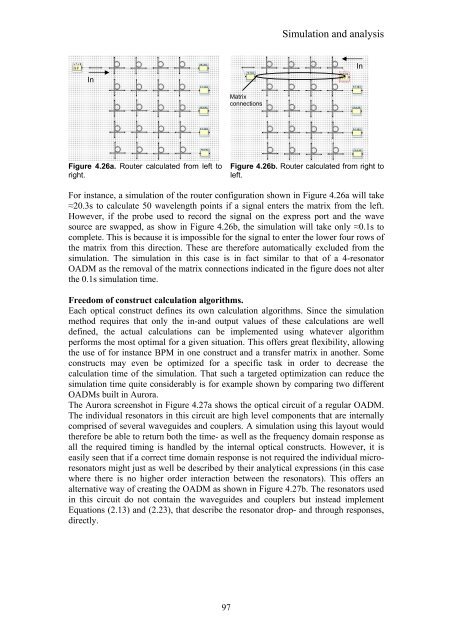Edwin Jan Klein - Universiteit Twente
Edwin Jan Klein - Universiteit Twente
Edwin Jan Klein - Universiteit Twente
You also want an ePaper? Increase the reach of your titles
YUMPU automatically turns print PDFs into web optimized ePapers that Google loves.
In<br />
Figure 4.26a. Router calculated from left to<br />
right.<br />
97<br />
Matrix<br />
connections<br />
Simulation and analysis<br />
Figure 4.26b. Router calculated from right to<br />
left.<br />
For instance, a simulation of the router configuration shown in Figure 4.26a will take<br />
≈20.3s to calculate 50 wavelength points if a signal enters the matrix from the left.<br />
However, if the probe used to record the signal on the express port and the wave<br />
source are swapped, as show in Figure 4.26b, the simulation will take only ≈0.1s to<br />
complete. This is because it is impossible for the signal to enter the lower four rows of<br />
the matrix from this direction. These are therefore automatically excluded from the<br />
simulation. The simulation in this case is in fact similar to that of a 4-resonator<br />
OADM as the removal of the matrix connections indicated in the figure does not alter<br />
the 0.1s simulation time.<br />
Freedom of construct calculation algorithms.<br />
Each optical construct defines its own calculation algorithms. Since the simulation<br />
method requires that only the in-and output values of these calculations are well<br />
defined, the actual calculations can be implemented using whatever algorithm<br />
performs the most optimal for a given situation. This offers great flexibility, allowing<br />
the use of for instance BPM in one construct and a transfer matrix in another. Some<br />
constructs may even be optimized for a specific task in order to decrease the<br />
calculation time of the simulation. That such a targeted optimization can reduce the<br />
simulation time quite considerably is for example shown by comparing two different<br />
OADMs built in Aurora.<br />
The Aurora screenshot in Figure 4.27a shows the optical circuit of a regular OADM.<br />
The individual resonators in this circuit are high level components that are internally<br />
comprised of several waveguides and couplers. A simulation using this layout would<br />
therefore be able to return both the time- as well as the frequency domain response as<br />
all the required timing is handled by the internal optical constructs. However, it is<br />
easily seen that if a correct time domain response is not required the individual microresonators<br />
might just as well be described by their analytical expressions (in this case<br />
where there is no higher order interaction between the resonators). This offers an<br />
alternative way of creating the OADM as shown in Figure 4.27b. The resonators used<br />
in this circuit do not contain the waveguides and couplers but instead implement<br />
Equations (2.13) and (2.23), that describe the resonator drop- and through responses,<br />
directly.<br />
In















